MARIANI’SVirtual
Gourmet
March 30, 2014
NEWSLETTER
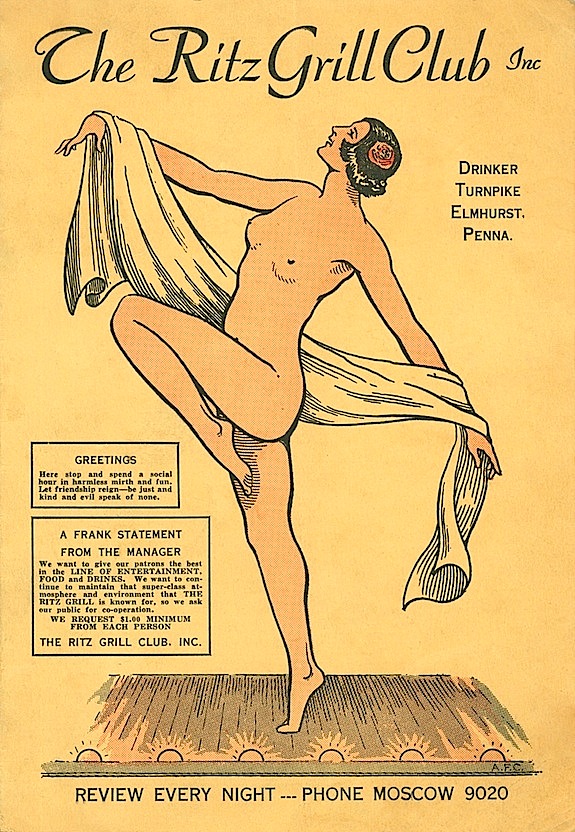
IN THIS ISSUE
PIZZA AGONISTES
By John Mariani
CANCEL MY DINNER RESERVATIONS IN GEORGIA
By John Mariani
NEW YORK CORNER
Il Cantinori
By John Mariani
NOTES FROM THE WINE CELLAR
TEXAS TANNATS GO HEAD TO
HEAD WITH CALIFORNIA
by Andrew Chalk
❖❖❖
PIZZA AGONISTES
By John Mariani

It’s been a bad month
for bad pizza. First, Sbarro announced the closing
of 155 of its 400 U.S. stores, then declared
bankruptcy. Again. Then, in one of the few
conservative judicial decisions I actually
applaud, Justice Antonin Scalia, born in Trenton,
NJ, declared that Chicago-style deep-dish pizza
“shouldn’t be called pizza. It’s very tasty, but
it’s not pizza.”
Curiously enough,
these two seemingly unrelated incidents actually
prove that inferior pizza is on the wane.
(Well, not entirely, Pizza Hut, which makes
the worst pizza on Earth, still has more than 6,000
U.S. locations, and more than 5,000 in 94 other
countries.) The good news is that pizza is
going through a renaissance of quality, having
passed from its humble Neapolitan origins as poor
people’s food to its first outpost in New York--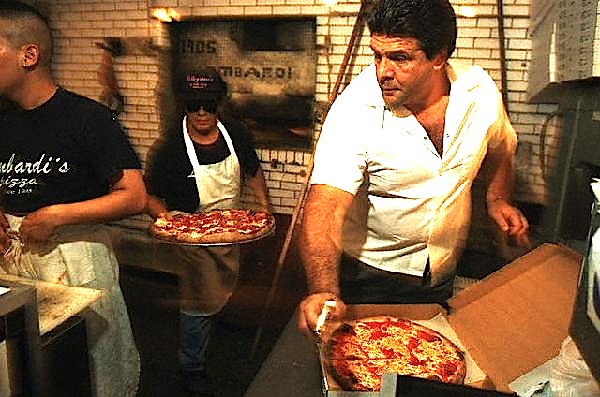 Lombardi’s (left) opened in 1905 on Spring
Street and is still there--to becoming a favorite
snack food across the U.S. by the 1960s, when the
corruption really set in. Sbarro, which
started out in 1956 in Brooklyn and became a staple
of mall food courts when it went public in 1985, is
far from making truly bad pizza, even if its crust
is too doughy and its toppings insipid. The demise
of pizza in America really began when chains--most
of them out of the Midwest--like Pizza Hut,
Domino’s, Little Caesars, and Godfather--these last
two blithely and despicably trading on Italian
gangster stereotypes (below)--created a Middle American
style pizza of daunting size, heaviness and distaste
than bore no resemblance to the Neapolitan model.
Then the very American impetus to pile
on became competitive: Little Caesars'
Ultimate Supreme Pizza is topped with pepperoni,
Italian sausage, green peppers, mushrooms, and
onions on a thick crust with the consistency of a
bread stick, while Pizza Hut’s Super Supreme Pizza (goes way beyond
that, described as a “feast of pepperoni, ham, beef, pork
sausage, Italian sausage, red onions, mushrooms,
green peppers and black olives”--just the thing to
give pizza a bad name as artery-clogging,
gut-busting junk food.
Lombardi’s (left) opened in 1905 on Spring
Street and is still there--to becoming a favorite
snack food across the U.S. by the 1960s, when the
corruption really set in. Sbarro, which
started out in 1956 in Brooklyn and became a staple
of mall food courts when it went public in 1985, is
far from making truly bad pizza, even if its crust
is too doughy and its toppings insipid. The demise
of pizza in America really began when chains--most
of them out of the Midwest--like Pizza Hut,
Domino’s, Little Caesars, and Godfather--these last
two blithely and despicably trading on Italian
gangster stereotypes (below)--created a Middle American
style pizza of daunting size, heaviness and distaste
than bore no resemblance to the Neapolitan model.
Then the very American impetus to pile
on became competitive: Little Caesars'
Ultimate Supreme Pizza is topped with pepperoni,
Italian sausage, green peppers, mushrooms, and
onions on a thick crust with the consistency of a
bread stick, while Pizza Hut’s Super Supreme Pizza (goes way beyond
that, described as a “feast of pepperoni, ham, beef, pork
sausage, Italian sausage, red onions, mushrooms,
green peppers and black olives”--just the thing to
give pizza a bad name as artery-clogging,
gut-busting junk food.
A pullback came
innocently enough, when California Earth Mother
Alice Waters began serving authentic, marvelously
crusted, charred and bubbly Neapolitan-style pizzas
at her Café at Chez Panisse, about the same
time Wolfgang Puck opened Spago in L.A., where he
made pizzas whose crust was just as rigorously
authentic but with out-of-the-ordinary first-quality
ingredients that included smoked salmon, caviar,
dill and sour cream, which he dubbed “Jewish pizza”
(below).
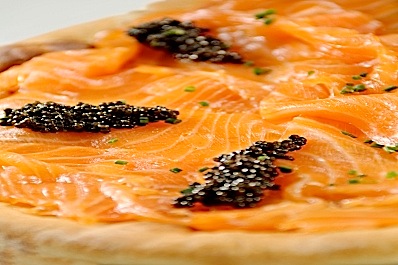 But it
was not until Italian food in this country
transcended the image of being greaseball fare that
pizza came along for the ride to eminence as a
legitimate dish that demanded respect for its
traditions as poor people’s food in 19th century
Naples.
But it
was not until Italian food in this country
transcended the image of being greaseball fare that
pizza came along for the ride to eminence as a
legitimate dish that demanded respect for its
traditions as poor people’s food in 19th century
Naples.
The problem was, as
always happens in the U.S., overeager young cooks
decided to exalt pizza by deconstructing every
element of the pie in an attempt to justify an
entirely new array of excesses in the name of
“gourmet pizza.” Wood-fired ovens were
held to be requisite for a good crust; the flour had
to be imported from Italy (even though the Italians
import their
flour from Minnesota); the chemical make-up of the
water was considered crucial; and along the way the
crust got fashionably thinner and thinner until it
was more a flatbread than a pizza.
Pioneers like Chris
Bianco (below)
of Pizza Bianco in Phoenix, Arizona--who once prided
himself on making every pizza, until the flour dust
got to his lungs--became heroes, even icons.
Entrepreneurs flew to Naples, ate at ten
pizzerias, declared themselves experts, then ordered
handcrafted pizza ovens to be shipped to the States,
which always arrived at least six months
late.
six months
late.
Photo: Nikki Buchanan
Inevitably
followed scores of articles in national and city
magazines in high dudgeon over who made the best
pizzas in America, and the whole thing became
typically overblown, overthought, and really really
boring.
But, as is also the
case in America, these dithyrambs of exhaustive
scrutiny got old and the copy got thin, as the next
new thing demanded immediate attention.
And this is why we are now in a
pizza renaissance: after pizza wars in New York,
L.A., Boston, San Francisco, and other major cities,
the wonderful fall-out of those battles is that you
can now get a good pizza just about anywhere in the
U.S., as long as it’s not at a chain.
The mystery of making
a good pizza has been solved, and it’s not all that
difficult, assuming some publicity-freak cook
doesn’t intend to top his pizzas with, oh, I don’t
know, leaves and lichen. Contemporary ovens,
which need not be made of brick or wood- or
coal-fired, almost guarantee a good crust if the
cook has a commitment to the crafting and stretching
of the dough in order to create those charred
bubbles, chewy-crunchy crust, and yeasty aroma that
permeates the ingredients put on top of the pie.
And, of course, high quality ingredients are
easier to buy than ever before--excellent olive oil,
fine salami and sausage, fresh basil, artisanal
cheeses.
As a kid from the
Bronx I no longer feel the need to declare all
pizzas outside of New York second-rate--not that I
don't have my favorites here--although I totally
agree with Justice Scalia about the abomination
called Chicago deep-dish pizza. I have had
first-rate pizzas all over the U.S., classic
Margheritas, spicy pepperoni, with Gorgonzola and
caramelized figs, arugula and goat’s cheese, and
pastrami and fontina.
 And while I rarely took
the time to make pizza at home--which takes
incessant practice to perfect the dough, then
heating up a pizza stone for an hour till it’s maybe
500 degrees--I’ve actually found a little miracle
device called the Newwave Pizza Maker that heats up
to 600 degrees in five minutes and makes a perfect
pizza in under
five minutes--provided you buy good pizza dough, now
readily available. The thing’s made in Taiwan and
you can find it for $79-$100.
And while I rarely took
the time to make pizza at home--which takes
incessant practice to perfect the dough, then
heating up a pizza stone for an hour till it’s maybe
500 degrees--I’ve actually found a little miracle
device called the Newwave Pizza Maker that heats up
to 600 degrees in five minutes and makes a perfect
pizza in under
five minutes--provided you buy good pizza dough, now
readily available. The thing’s made in Taiwan and
you can find it for $79-$100.
So,
in its renaissance, pizza is returning to its humble
roots, and with the dissipation of gourmet madness
on the subject, we very easily go to a neighborhood
pizzeria with a name like Vinny’s Original or La
Dolce Vita Pizza, sit down and nurse a Peroni beer
(which is really pretty good now), then swoon when
the steaming hot pie is brought out and set on a
metal stand, and the waiter says, “It’s really hot.
Don’t burn your mouth.” But you can’t
wait, and you do.
❖❖❖
CANCEL
MY DINNER RESERVATIONS IN GEORGIA
By
John Mariani
The news that Georgia Gov.
Nathan Deal (right)
is expected to sign a bill that will allow
licensed guns in bars, restaurants, schools,
churches and airports is simply chilling.
Indeed, an Atlanta
Journal-Constitution poll that found more
than 70 percent of voters opposed such a measure, as
well as the state’s police chiefs association,
restaurant association, and Episcopal and Catholic
churches, not to mention the Federal Transportation
Security Administration.
Fueled by The National Rifle Association
(NRA) that calls the bill “the most comprehensive
gun” bill in recent state history, the enthusiasm
for such an appalling idea among state legislators
will run right over their own constituents’ concerns
about going out to dinner and sitting next to a guy
packing heat.
Are parents going to take their children to
McDonald’s and stand in line with a hungry NRA
stooge with a G22 Glock stuck in his belt? And who
wants to go down to the well tonight to drink his
fill and see some lush slap his new semi-automatic
gun on the bar?

Georgia is not alone in such legislation: the
Law
Center to Prevent Gun Violence lists three
states that already allow guns in churches, two on
college campuses, eight in schools, and four
considering allowing them in bars; South Carolina
already does. One can only hope these laws are
challenged in state and federal courts.
I am not about to debate the Second Amendment
here but to equate carrying an unlicensed gun into a
bar or restaurant with a basic American right is
sheer idiocy.
Alcohol and guns don’t mix well in bars, and
what possible rationale is there to allow them into
a restaurant?
Well, here’s one possibility: under the rules
of Stand Your Ground, if the guy at the next table
flirts with your wife and you ask him to stop and he
tells you to go screw yourself and you see he’s got
a pistol in his belt, then you have a perfect right
to pull out your own gun and blow the sucker way—all
perfectly legal.
By the way, the same goes for the other guy.
A champagne cork pops across the dining room.
A guy whips out his revolver, it accidentally
discharges, and you get hit in the chest. 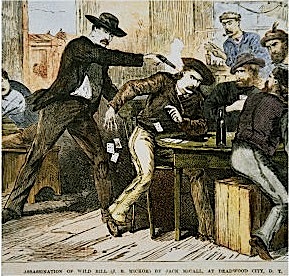 Oops!
Oops!
It is well to remember that in the Old West,
contrary to fictionalized movie shoot-outs in
saloons, the first things everyone had to do upon
arrival in town was to surrender his guns to the
sheriff’s office or at least hand them over to the
bartender. Had
someone relieved “Crooked Nose” Jack McCall of his
pistol in Deadwood, South Dakota, he couldn’t have
walked into the No. 10 Saloon that August day in
1876 and shot Wild Bill Hickok dead with a bullet to
the back of his head (right).
I would
have thought that Georgia's legislators would be
more enlightened than some western states about the
dangerous consequences of allowing guns in bars and
restaurants, and all it will take is a few bar
owners and restaurateurs to test the law by posting
signs saying “No Guns Allowed.”
Until that happens, cancel my
reservations in Atlanta, including at a restaurant
called Gunshow, whose chef-owner, Kevin Gillespie,
named the place as homage to his father, who took
his young son for bonding experiences to gun shows
on Sundays.
The Second Amendment is a reasonable one, but
any reasonable person will wonder whether it was
intended to promote the kind of arrogant license now
being shoved through state legislatures. Reminds
me of the lyrics in the song by the Charlie Daniels
Band, “The Devil Went Down to Georgia”:
Fire
on the Mountain. Run, boys, run!
The
Devil's in the house of the rising sun.
This article
originally ran in esquire.com
❖❖❖
By John Mariani
Il CANTINORI
32 East 10th Street (near Fifth Avenue)
212-673-6044
www.ilcantinori.com
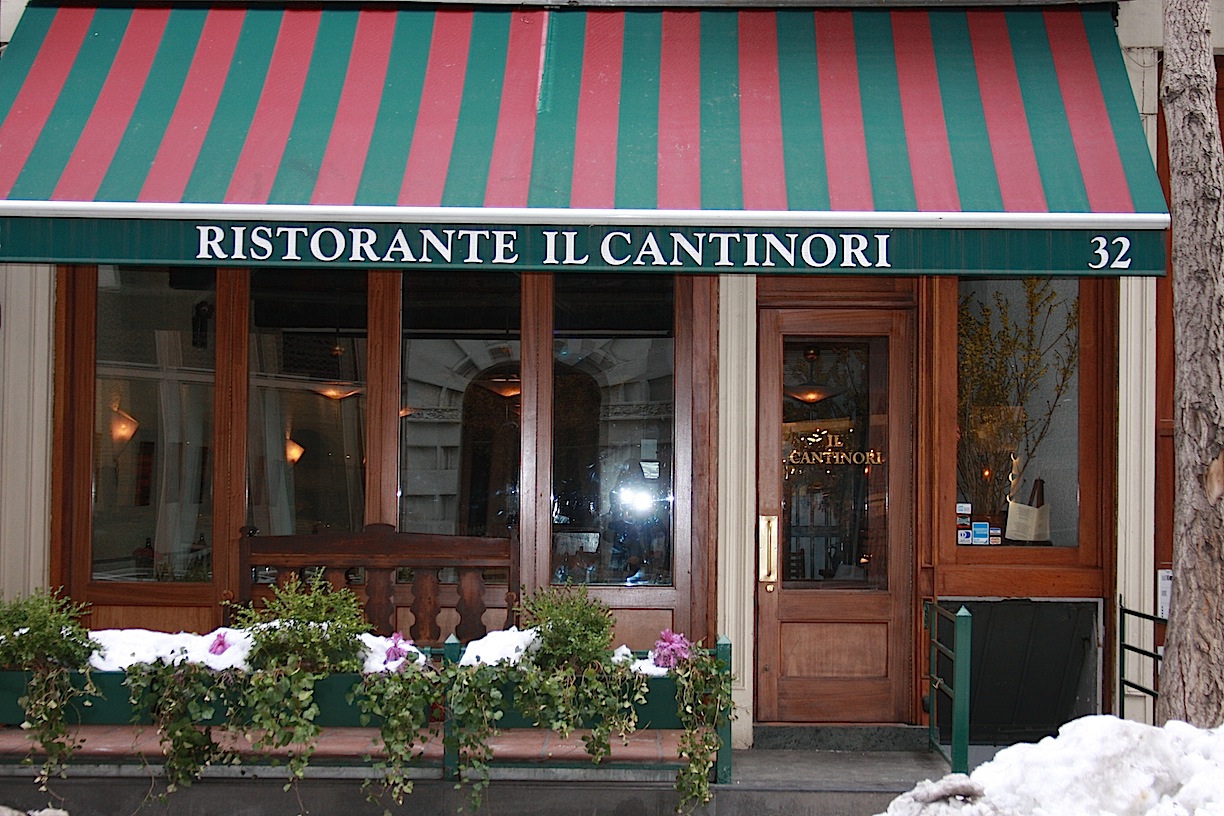 Il
Cantinori is that rare thing in New York:
It’s going into its fourth decade, looks pretty
much the same as it did in 1983, has a menu that
does not stray far from its Tuscan roots, and has
a fiercely faithful clientele that comes time
after time either to eat their favorite dishes or
to see what seasonal items Antonio Ciardi—here
from Day One—will tempt them with.
Il
Cantinori is that rare thing in New York:
It’s going into its fourth decade, looks pretty
much the same as it did in 1983, has a menu that
does not stray far from its Tuscan roots, and has
a fiercely faithful clientele that comes time
after time either to eat their favorite dishes or
to see what seasonal items Antonio Ciardi—here
from Day One—will tempt them with.
Il Cantinori’s design is handsome rather than
dazzling, yet from the start it has always
attracted the downtown artists, musicians and
fashionistas (the street is lined with galleries),
who bank on seeing one of the city’s grandest,
most effusive floral displays in the dining room’s
center table.
In the beginning, when nearby Da Silvano was the
hot restaurant for the Greenwich Village celebrity
crowd, Il Cantinori offered a fresh alternative.
Owners Steve Tzolis, Nicola Kotsoni
(of Periyali and Bar Six), and Frank Minieri,
teamed with former Da Silvano g-m Pino Luongo (now
owner of Moreso on the Upper East Side), who was
very much a proud Tuscan, and soon Il Cantinori
was catering to Vogue
fashion editors, Andy Warhol, Robert Mapplethorpe,
and Keith Haring, who one night drove a Vespa
right into the restaurant dining room. The
Hollywood crowd followed and all the attendant
glamour.
Today, you might not always
spot the higher echelons of the arts and movie
crowd on an every night basis, but Il Cantinori’s
regulars lend 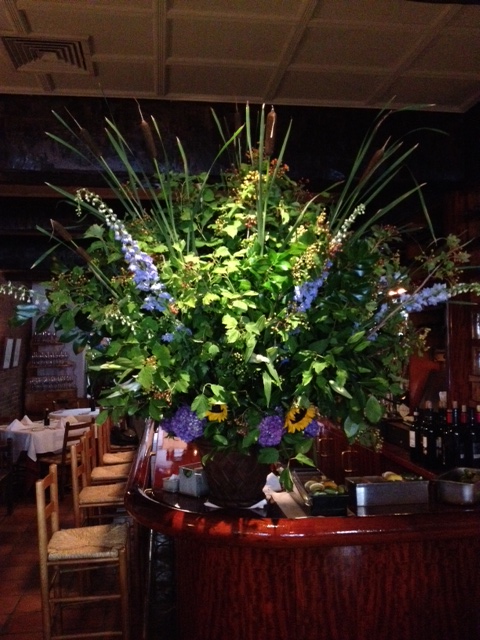 the place an
atmosphere that wholly fills the bill as a New
York-style trattoria. Frank Minieri is always
there to greet them by name.
the place an
atmosphere that wholly fills the bill as a New
York-style trattoria. Frank Minieri is always
there to greet them by name.
The menu breaks no new ground for Italian cuisine,
but the Tuscan theme is still largely intact, so
you might well begin with crostini
slathered with goose liver, garlic and a chestnut
puree ($20) or a cauliflower stew with bread
scented with thyme and doused with grated
Parmigiano ($14). On the night I visited the
mozzarella di
bufala and prosciutto ($19) came out cold,
the tomatoes pink, so the whole dish lacked
flavor.
Of
course, pastas are always the standouts in Italian
restaurants and Chef Ciardi has focused in on
simple flavors with the right texture and
condiments. So, fettuccine with rabbit
($21), scallions, white wine and thyme ragù
is as fine a rendering as you’d find in a
trattoria in Siena, as are the potato gnocchi,
light but substantial, with wild mushrooms and a
rich cream sauce ($19). I urge you to go for
the evening’s risotto, for Ciardi cooks the rice
to the perfect texture and suffuses it with the
chosen ingredients of the night and the aroma of
slowly cooked vegetable.
There is also a grilled fish of the evening, and
when I visited there could have been no
improvement in the moist Mediterranean sea bass
($34) as an example of impeccable timing.
Roasted squab ($31), cooked pink, was
earthy, accompanied by lush garlicky spinach and a
light mustard sauce, while a broiled marinated
rack of lamb for $38 is a remarkable price for
such a generous dish.
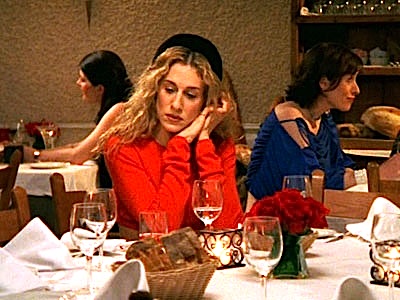 Having been
around for more than thirty years, Il Cantinori’s
wine list has grown and been renewed with an eye
towards quality at a reasonable price. There
are some older bottlings but it is from the small
estates that you find the most interesting labels.
Having been
around for more than thirty years, Il Cantinori’s
wine list has grown and been renewed with an eye
towards quality at a reasonable price. There
are some older bottlings but it is from the small
estates that you find the most interesting labels.
The desserts, as is so often the case in casual
Italian restaurants, are not Il Cantinori’s strong
point, though I think you’ll enjoy the house
cheesecake.
Il Cantinori carries on not only
because of its glam image—which was heightened
when the character Carrie in the TV show “Sex in
the City” had her forlorn 30th birthday party in
the restaurant (left)—but
because its patrons have adopted it as their
neighborhood go-to place, even if their
neighborhood is far uptown or across the ocean.
You might call it Pan-trattoria.
True, it was Restaurant Week when I visited, so
the place was jammed, but it’s pretty much that
way every night. After 31 years, that is
testament to a kitchen and staff that really
cares.
Il Cantinori is open for
lunch Mon.-Fri. and for dinner nightly.
❖❖❖
TEXAS
TANNAT GOES HEAD TO HEAD WITH CALIFORNIA
by Andrew
Chalk
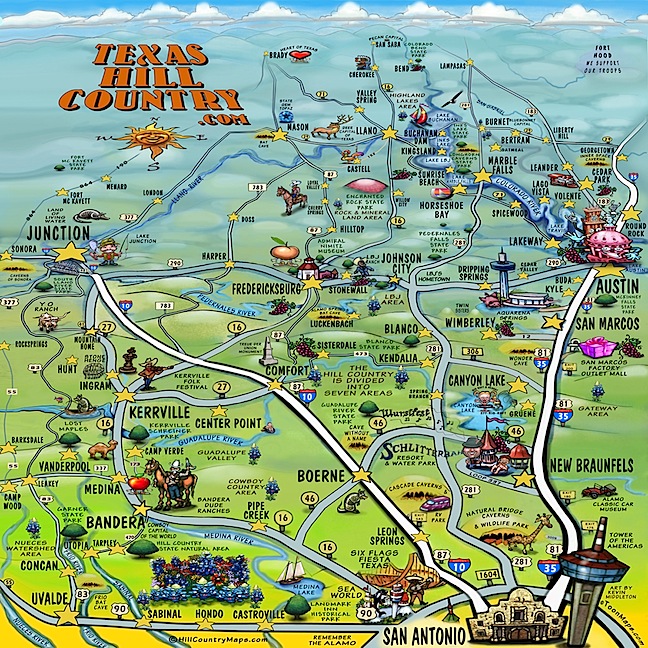 The
increasing interest in the Tannat grape as a
varietal with a bright future, especially in
Argentina and Uruguay, bolsters its
traditional role in France, where it is
produced, sometimes as a monovarietal,
in the southwestern enclave of Madiran and
grown as an important, but not the major,
component in Cahors.
The
increasing interest in the Tannat grape as a
varietal with a bright future, especially in
Argentina and Uruguay, bolsters its
traditional role in France, where it is
produced, sometimes as a monovarietal,
in the southwestern enclave of Madiran and
grown as an important, but not the major,
component in Cahors.
Tannat has
a reputation for intense, tannic wines that
display long aging potential. In fact, it was
in Madiran that a controversial winemaking
technique called micro-oxygenation was
invented, apparently as an attempt to soften
Tannat’s powerful tannins.
Even in Texas the
varietal has seen considerable growth and
promise, and it is being made with
accomplishment, as well as palpable passion,
at Bending
Branch Winery in the Texas Hill Country
northwest of Austin. Bending Branch Winery is
not the only Tannat producer in Texas, but it
is the first one I had heard about and the one
that got me appreciating the grape’s
possibilities in the state.
Here
was a chance to see if my enthusiasm for Texas
Tannat was warranted. How would 2010 Bending
Branch stand up, not against any old
domestic Tannat, but with other global
examples? I bought a bottle from the Bending
Branch web site (Texas wines are almost never
sold outside of the state) for $30. It has won
gold and silver medals in California and Texas
competitions.
As luck
would have it, I ran into Bending Branch’s
V.P. of Winery and Vineyard Operations at a
conference and told him of my plans. He
offered a bottle of the 2011 Bending Branch
“Estate Grown” ($60). This is the
first vintage from the winery’s estate
vineyard and was produced in a tiny quantity
of only 75 cases. Among its accolades was the
‘Top Texas Wine’ award at the 2014 Houston
Livestock & Rodeo Wine Competition, one of
the state’s top wine competitions.
I
wanted to match it up with a Tannat from
Monterey, California--Cambiata,
which was a bit trickier to get hold of. It is
not available locally or through the winery
web site and there were only a few sellers on
the Internet. It took some time to find one, Sunfish
Cellars , that could ship to Texas.
Who
would judge these wines? I figured that if I
did the tasting solo, the results would have
about as much credibility as Lance Armstrong’s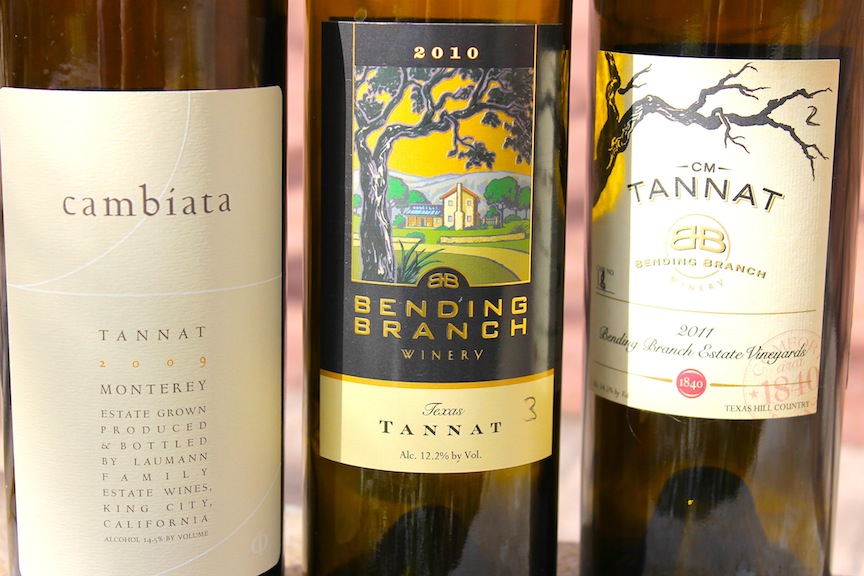 views on cycling
and diet, so I pressed-ganged a couple of
trained professional palates in for a blind
tasting. One was a Master of Wine, Dilek
Caner, and one Advanced Sommelier and
candidate for the Master Sommelier exam,
Steve Murphey.
views on cycling
and diet, so I pressed-ganged a couple of
trained professional palates in for a blind
tasting. One was a Master of Wine, Dilek
Caner, and one Advanced Sommelier and
candidate for the Master Sommelier exam,
Steve Murphey.
The
results were interesting. Dilek thought the
2010 Texas Bending Branch better than its 2011
Estate Vineyard wine. The former had a very
appealing fruit nose with notes of black
cherry, basil, thyme, tarragon, vanilla,
nutmeg clove and cranberry. On the palate the
wine was very well balanced with plenty of
ripe tannins. With the 2011, she felt that the
nose was not clean, affected by notes of
acetic acid. Overall, she placed the Cambiata
best overall for its powerful expression of
dark fruit and complexity.
Steve veered the
other way on the two Bending Branch examples.
He found the palate on the 2011 to be ‘juicy’
with notes of red delicious apple skin, roses,
violets, blackberry cobbler. There was briary,
tart and ripe fruit at the same time and a wet
river rock minerality. He concluded that it
“seems like a more complete wine with
elements of minerality, oak and fruit.” He
also gave the Cambiata the nod as the best
wine of the three.
For
my part, I preferred the 2010 Bending Branch
to the 2011, but this may have been because
its extra year of age had given the palate
time to develop. In addition, I liked the dark
fruit (plums and blueberries) that I found in
the nose. The Cambiata again took the brass
ring, but, since I am talking about my own
tastes here, I can say that it was not by
much. Given the lean bench of experience
making Tannat at Bending Branch, the results
of this tasting are a real success story and
the grape's prospects are promising.
❖❖❖
OF LIONS AND LAMBS

by Cristina Mariani-May
co-CEO of Banfi
Vintners America's leading wine
importer
In English, we
say March comes
in like a lion and goes out like a lamb, at
least in the northeast US. In Italian, the saying is more
to the point: Marzo é
matto – March is mad. Beginning or end, you never know
what you’re in for – snow-capped daffodils, frost on
the pansies, hail in the gardenias, a weekend heat
wave broken by a blizzard… light the fireplace or turn
over the garden? Matto, matto,
matto. What
to wear? Forget
that! What to drink?
The abundance
of fresh local vegetables hasn’t quite hit the
supermarket shelves yet, and even the spring lamb
hasn’t quite sprung.
Delicate white wines and light bodied reds are
still on hold until the barbecue gets lit. On the
other hand, those heavy roasts and full-bodied reds
conjure too many memories of deep winter snowstorms. So for Marzo il Matto,
March the Mad, let’s continue the alliteration with
our theme for the month: Medium.
Medium bodied
wines may sound willy-nilly for such an assertive
month, but in reality they represent the flexibility
we’ll need to deal with this seasonal Sybil. On the
white side, a well-balanced Chardonnay would fit the
bill nicely. Of
late it seems that there has been a tremendous
backlash to the over-lived trend of over-oaked
Chardonnays, and the word ‘un-oaked’ has become a
battle cry. As
much as I appreciate those clean, crisp sippers, I
defer from an over-reaction from one extreme to the
other. I
submit that, as in all things, moderation is good
thing when it comes to the marriage of wine and wood. If we can
think of wine as a beautiful piece of art, with the
fruit as the painting on the canvas, then the wood
should be the subtle frame that holds it all together,
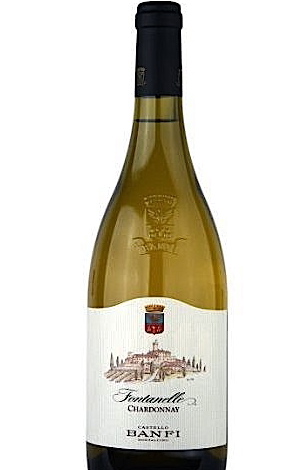 adding balance
and perspective.
adding balance
and perspective.
Fontanelle Chardonnay is such a
piece of artwork, a single vineyard Chardonnay from
Montalcino in the heart of southern Tuscany. Okay, so
Chardonnay is not a varietal that you would normally
associate with Tuscany, but this one from the land of
Brunello will show you that man (and woman) cannot
live by red alone.
This is a rich wine from poor soil, the magic
formula of any good winemaker. The land
around Montalcino, and my family’s estate in
particular, is very rich in clay and poor in
nutrients, making it challenging -- think of it as
surviving more than thriving -- for all but the
heartiest of fruits and vegetables to grow, and a
particular effort for these grape vines.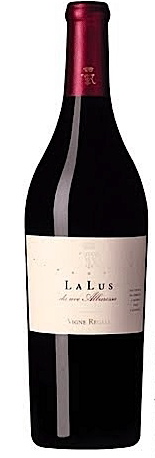 But as my
mother likes to remind me, only a parent who knows
suffering can bear good fruit… and this wine is a
child to make any parent proud.
But as my
mother likes to remind me, only a parent who knows
suffering can bear good fruit… and this wine is a
child to make any parent proud.
The grapes
for Fontanelle Chardonnay are grown in the
southwestern part of our estate, on a ridge that runs
east to west and slopes slightly to the south,
centered by a farm house built around a small fountain
– the literal translation of the site and the wine, fontanelle,
the little fountain.
After the hand-selected grapes are cooled and
crushed, the clear must is racked and 75% of it put in
2-year-old barrels to start fermentation. Over the
course of the next five or six months, the wood helps
the wine breath and adds some character and depth,
which is also accented by time spent on the lees – the
natural yeast cells that offer complexity and
roundness.
This wine is
a fountain of flavors, and reminds me of the peaches
and apricots that grow in the nearby orchard, with a
hint of rosemary and sage that grow in the farmhouse
garden.
Cristina Mariani is not related by family or
through business with John Mariani, publisher of
this newsletter
OY VEH!

Katz's Delicatessen, the
125-year-old Jewish deli in NYC, has sued the owners of
a food truck company named Katz & Dogz for stealing
and tarnishing its good name. The truck owners also
referenced the famous Katz's scene
from When Harry Met Sally when Sally fakes an
orgasm with a sign on the side of the Katz
& Dogz trucks reading,
"Are you
ready for the REUBEN ORGASM?!".
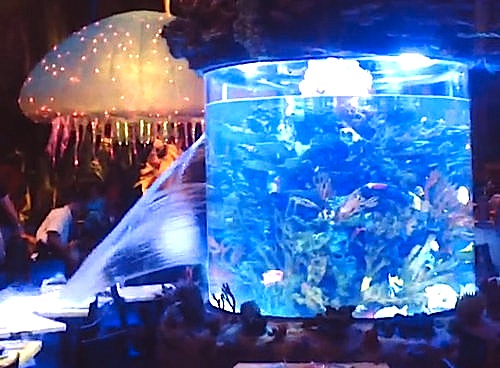 OOPSY!
OOPSY!
❖❖❖
Any of John Mariani's
books below may be ordered from amazon.com.
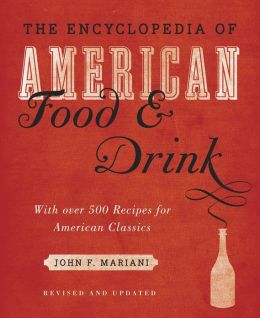 |
The Encyclopedia of American Food and Drink by John F. Mariani (Bloomsbury USA, $35) Modesty forbids me to praise my own new book, but let me proudly say that it is an extensive revision of the 4th edition that appeared more than a decade ago, before locavores, molecular cuisine, modernist cuisine, the Food Network and so much more, now included. Word origins have been completely updated, as have per capita consumption and production stats. Most important, for the first time since publication in the 1980s, the book includes more than 100 biographies of Americans who have changed the way we cook, eat and drink -- from Fannie Farmer and Julia Child to Robert Mondavi and Thomas Keller. "This book is amazing! It has entries for everything from `abalone' to `zwieback,' plus more than 500 recipes for classic American dishes and drinks."--Devra First, The Boston Globe. "Much needed in any kitchen library."--Bon Appetit. |
"Eating Italian will never be the same after reading John Mariani's entertaining and savory gastronomical history of the cuisine of Italy and how it won over appetites worldwide. . . . This book is such a tasteful narrative that it will literally make you hungry for Italian food and arouse your appetite for gastronomical history."--Don Oldenburg, USA Today. "Italian
restaurants--some good, some glitzy--far
outnumber their French rivals. Many of
these establishments are zestfully described
in How Italian Food Conquered the World, an
entertaining and fact-filled chronicle by
food-and-wine correspondent John F.
Mariani."--Aram Bakshian Jr., Wall Street
Journal.
"Equal parts
history, sociology, gastronomy, and just
plain fun, How Italian Food Conquered the
World tells the captivating and delicious
story of the (let's face it) everybody's
favorite cuisine with clarity, verve and
more than one surprise."--Colman Andrews,
editorial director of The Daily
Meal.com. "A fantastic and fascinating
read, covering everything from the influence
of Venice's spice trade to the impact of
Italian immigrants in America and the
evolution of alta cucina. This book will
serve as a terrific resource to anyone
interested in the real story of Italian
food."--Mary Ann Esposito, host of PBS-TV's
Ciao
Italia. "John Mariani has written the
definitive history of how Italians won their
way into our hearts, minds, and
stomachs. It's a story of pleasure over
pomp and taste over technique."--Danny Meyer,
owner of NYC restaurants Union Square
Cafe, The Modern, and Maialino.
|
 |
 |
 |
 |
 |
 |
 |
 |
 Everett Potter's Travel Report:
Everett Potter's Travel Report: 
 Eating Las
Vegas is the new on-line site for
Virtual Gourmet contributor John A. Curtas.,
who since 1995 has been commenting on the
Las Vegas food scene and reviewing
restaurants for Nevada Public Radio.
He is also the restaurant critic for KLAS
TV, Channel 8 in Las Vegas, and his past
reviews can be accessed at KNPR.org.
Click on the logo below to go directly to
his site.
Eating Las
Vegas is the new on-line site for
Virtual Gourmet contributor John A. Curtas.,
who since 1995 has been commenting on the
Las Vegas food scene and reviewing
restaurants for Nevada Public Radio.
He is also the restaurant critic for KLAS
TV, Channel 8 in Las Vegas, and his past
reviews can be accessed at KNPR.org.
Click on the logo below to go directly to
his site.

Tennis Resorts Online: A Critical Guide to the World's Best Tennis Resorts and Tennis Camps, published by ROGER COX, who has spent more than two decades writing about tennis travel, including a 17-year stretch for Tennis magazine. He has also written for Arthur Frommer's Budget Travel, New York Magazine, Travel & Leisure, Esquire, Money, USTA Magazine, Men's Journal, and The Robb Report. He has authored two books-The World's Best Tennis Vacations (Stephen Greene Press/Viking Penguin, 1990) and The Best Places to Stay in the Rockies (Houghton Mifflin, 1992 & 1994), and the Melbourne (Australia) chapter to the Wall Street Journal Business Guide to Cities of the Pacific Rim (Fodor's Travel Guides, 1991).


MARIANI'S VIRTUAL GOURMET
NEWSLETTER is published weekly. Editor/Publisher: John
Mariani.
Editor: Walter Bagley. Contributing Writers: Christopher Mariani,
Robert Mariani, John A.
Curtas, Edward Brivio, Mort Hochstein, Suzanne
Wright, and Brian Freedman. Contributing
Photographers: Galina Stepanoff-Dargery,
Bobby Pirillo. Technical Advisor: Gerry McLoughlin.
© copyright John Mariani 2014
